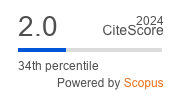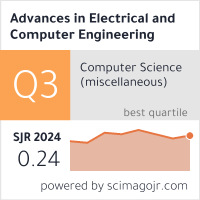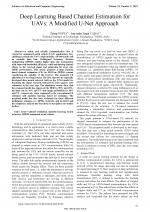| 1/2025 - 7 |
Deep Learning Based Channel Estimation for UAVs: A Modified U-Net ApproachGUPTA, C. |
| Extra paper information in |
| Click to see author's profile in |
| Download PDF |
Author keywords
channel estimation, machine learning, neural networks, OFDM, unmanned aerial vehicle
References keywords
communications(16), channel(12), ofdm(10), estimation(10), deep(10), communication(10), systems(9), learning(7), networks(6), letters(6)
Blue keywords are present in both the references section and the paper title.
About this article
Date of Publication: 2025-02-28
Volume 25, Issue 1, Year 2025, On page(s): 61 - 70
ISSN: 1582-7445, e-ISSN: 1844-7600
Digital Object Identifier: 10.4316/AECE.2025.01007
Web of Science Accession Number: 001440647300006
SCOPUS ID: 86000354176
Abstract
A stable and reliable communication link is crucial for unmanned aerial vehicle (UAV) applications. Key challenges include the UAV's high mobility (10-100 km/h) and an unstable data link. Orthogonal frequency division multiplexing (OFDM) enables higher data rate transmission with improved bandwidth efficiency, while minimizing channel effects on the received signal and enhancing bit error rate (BER) performance. This article proposes a deep learning based channel estimation (CE) for 802.11ac OFDM systems considering the mobility of the receiver. The proposed CE algorithm is a two-step process. The first step uses an especially developed deep neural network built on the U-Net model for denoising the signal received, followed by least squares (LS) estimation in the next step. The simulation results show that the proposed model has improved the BER by 50% and 40%, the data rate by 10% and 7% and outage probability by 10% and 7%, respectively, when compared to the conventional LS estimator and machine learning based LS estimator. The proposed model has also been evaluated for three different modulation schemes, i.e., QPSK, 16-QAM, and 64-QAM and the complexity analysis has been done to strengthen our studies further. |
| References | | | Cited By «-- Click to see who has cited this paper |
| [1] M. Banafaa, O. Pepeoglu, I. Shayea, A. Alhammadi, Z. Shamsan, M. A. Razaz, M. Alsagabi, and S. Al-Sowayan, "A comprehensive survey on 5G and beyond networks with UAVs: Applications, emerging technologies, regulatory aspects, research trends and challenges," IEEE Access, Vol. 12, pp. 7786-7826, 2024. [CrossRef] [Web of Science Times Cited 72] [SCOPUS Times Cited 117] [2] S. Hafeez, A. R. Khan, M. M. Al-Quraan, L. Mohjazi, A. Zoha, M. A. Imran, and Y. Sun, "Blockchain-assisted UAV communication systems: A comprehensive survey," IEEE Open Journal of Vehicular Technology, vol. 4, pp. 558-580, 2023. [CrossRef] [Web of Science Times Cited 40] [SCOPUS Times Cited 68] [3] A. Sharma, P. Vanjani, N. Paliwal, C. M. W. Basnayaka, D. N. K. Jayakody, H.-C. Wang, and P. Muthuchidambaranathan, "Communication and networking technologies for UAVs: A survey," Journal of Network and Computer Applications, vol. 168, p. 102739, 2020. [CrossRef] [4] Y. Jia, X. Tu, and W. Yan, "An UAV wireless communication noise suppression method based on OFDM modulation and demodulation," Radio Science, vol. 55, no. 2, pp. 1-14, 2020. [CrossRef] [Web of Science Times Cited 8] [SCOPUS Times Cited 11] [5] A. Fereidountabar, G. C. Cardarilli, L. Di Nunzio, and R. Fazzolari, "UAV channel estimation with STBC in MIMO systems," Procedia Computer Science, vol. 73, pp. 426-434, 2015. [CrossRef] [Web of Science Times Cited 5] [SCOPUS Times Cited 6] [6] Q. Wang, W. Yang, S. Xu, and X. Pei, "OFDM with Index Modulation for UAV Communication Systems," in 2019 IEEE 5th International Conference on Computer and Communications (ICCC). IEEE, pp. 1047-1052, 2019. [CrossRef] [SCOPUS Times Cited 12] [7] C. Rezgui and K. Grayaa, "An enhanced channel estimation technique with adaptive pilot spacing for OFDM system," in 2016 International Symposium on Networks, Computers and Communications (ISNCC). IEEE, pp. 1-4, 2016. [CrossRef] [SCOPUS Times Cited 8] [8] A. M. S. Abdelgader, S. Feng, and L. Wu, "On channel estimation in vehicular networks," IET Communications, vol. 11, no. 1, pp. 142 149, 2017. [CrossRef] [Web of Science Times Cited 13] [SCOPUS Times Cited 16] [9] L. Yang, R. Tian, M. Jia, and F. Li, "A modified LS channel estimation algorithm for OFDM system in mountain wireless environment," Procedia Engineering, vol. 29, pp. 2732-2736, 2012. [CrossRef] [Web of Science Times Cited 6] [SCOPUS Times Cited 10] [10] Y. Liao, Y. Hua, and Y. Cai, "Deep learning-based channel estimation algorithm for fast time-varying MIMO-OFDM systems," IEEE Communications Letters, vol. 24, no. 3, pp. 572-576, March 2020. [CrossRef] [Web of Science Times Cited 67] [SCOPUS Times Cited 98] [11] M. Soltani, V. Pourahmadi, A. Mirzaei, and H. Sheikhzadeh, "Deep learning-based channel estimation," IEEE Communications Letters, vol. 23, no. 4, pp. 652-655, 2019. [CrossRef] [SCOPUS Times Cited 621] [12] X. Cheng, D. Liu, C. Wang, S. Yan, and Z. Zhu, "Deep learning-based channel estimation and equalization scheme for FBMC/OQAM systems," IEEE Wireless Communications Letters, vol. 8, no. 3, pp. 881-884, 2019. [CrossRef] [SCOPUS Times Cited 68] [13] Q. Zhang, G. Chen, B. Liu, X. Zhi, S. Zhan, J. Zhang, N. Jiang, B. Cao, and Z. Li, "An autoencoder-based transceiver for UAV-to-Ground free space optical communication," in 2023 Opto-Electronics and Communications Conference (OECC). IEEE, pp. 1-3, 2023. [CrossRef] [SCOPUS Times Cited 1] [14] X. Bai, "Design of UAV wireless communication system," in Journal of Physics: Conference Series, vol. 2649, no. 1. IOP Publishing, pp. 012-061, 2023. [CrossRef] [SCOPUS Times Cited 1] [15] K. Zhang, W. Zuo, Y. Chen, D. Meng, and L. Zhang, "Beyond a Gaussian denoiser: Residual learning of deep CNN for image denoising," IEEE transactions on image processing, vol. 26, no. 7, pp. 3142-3155, 2017. [CrossRef] [SCOPUS Times Cited 7673] [16] Z. Wu, H. Kumar, and A. Davari, "Performance evaluation of OFDM transmission in UAV wireless communication," in Proceedings of the Thirty-Seventh Southeastern Symposium on System Theory, SSST'05. IEEE, pp. 6-10, 2005. [CrossRef] [SCOPUS Times Cited 51] [17] C. Qing, Z. Liu, W. Hu, Y. Zhang, X. Cai, and P. Du, "LoS sensing based channel estimation in UAV-assisted OFDM systems," IEEE Wireless Communications Letters, vol. 13, no. 5, pp. 1320-1324, May 2024. [CrossRef] [SCOPUS Times Cited 22] [18] R. Han, J. Ma, and L. Bai, "Trajectory planning for OTFS-based UAV communications," China Communications, vol. 20, no. 1, pp. 114-124, 2023. [CrossRef] [SCOPUS Times Cited 15] [19] S. Li, N. Zhang, H. Chen, S. Lin, and H. Wu, "Joint subcarrier allocation, modulation mode selection, and trajectory design in a UAV-based OFDMA network," IEEE Communications Letters, vol. 26, no. 9, pp. 2111-2115, 2022. [CrossRef] [SCOPUS Times Cited 15] [20] F. Kulsoom, I. Fatima, H. N. Chaudhry, A. Gul, and A. Akram, "A robust carrier frequency and timing offset estimation in inter-UAV OFDM communication links," in 2023 7th International Multi-Topic ICT Conference (IMTIC). IEEE, pp. 1-5, 2023. [CrossRef] [SCOPUS Times Cited 6] [21] F. Linsalata, A. Albanese, V. Sciancalepore, F. Roveda, M. Magarini, and X. Costa-Perez, "OTFS-superimposed PRACH-aided localization for UAV safety applications," in 2021 IEEE Global Communications Conference (GLOBECOM). IEEE, pp. 1-6, 2021. [CrossRef] [SCOPUS Times Cited 25] [22] H. Ye, G. Y. Li, and B.-H. Juang, "Power of deep learning for channel estimation and signal detection in OFDM systems," IEEE Wireless Communications Letters, vol. 7, no. 1, pp. 114-117, 2017. [CrossRef] [SCOPUS Times Cited 1658] [23] E. Balevi, A. Doshi, and J. G. Andrews, "Massive MIMO channel es- timation with an untrained deep neural network," IEEE Transactions on Wireless Communications, vol. 19, no. 3, pp. 2079-2090, 2020. [CrossRef] [SCOPUS Times Cited 162] [24] H. Q. Ngo, E. G. Larsson, and T. L. Marzetta, "The multicell multiuser MIMO uplink with very large antenna arrays and a finite dimensional channel," IEEE Transactions on Communications, vol. 61, no. 6, pp. 2350-2361, 2013. [CrossRef] [SCOPUS Times Cited 271] [25] D. Ulyanov, A. Vedaldi, and V. Lempitsky, "Deep image prior," in Proceedings of the IEEE conference on computer vision and pattern recognition, pp. 9446-9454, 2018. [CrossRef] [SCOPUS Times Cited 672] [26] O. Ronneberger, P. Fischer, and T. Brox, "U-net: Convolutional networks for biomedical image segmentation," in International Conference on Medical image computing and computer-assisted intervention. Springer, pp. 234-241, 2015. [CrossRef] [SCOPUS Times Cited 76802] [27] S. Dorner, S. Cammerer, J. Hoydis, and S. Ten Brink, "Deep learning-based communication over the air," IEEE Journal of Selected Topics in Signal Processing, vol. 12, no. 1, pp. 132-143, 2017. [CrossRef] [SCOPUS Times Cited 719] [28] M. H. Essai Ali, "Deep learning-based pilot-assisted channel state estimator for OFDM systems," IET Communications, vol. 15, no. 2, pp. 257-264, 2021. [CrossRef] [SCOPUS Times Cited 25] [29] I. Y. Abualhaol and M. M. Matalgah, "Performance analysis of cooperative multi-carrier relay-based UAV networks over generalized fading channels," International Journal of Communication Systems, vol. 24, no. 8, pp. 1049-1064, 2011. [CrossRef] [Web of Science Times Cited 21] [SCOPUS Times Cited 27] [30] H.Younes, A.Mohamad, I.Ali, R.Mostafa, and V.Maurizio, "Efficient algorithms for embedded tactile data processing," In Electronic Skin, pp. 113-138. River Publishers, 2022. [CrossRef] [31] D. Sarkar, Yogita, S. S. Yadav, L. R. Cenkeramaddi and O. J. Pandey, "TDRA: Transformer based deep recurrent architecture for automatic modulation classification (AMC) pertinent to intelligent reflecting surface assisted internet of things (IoT) networks," in IEEE Internet of Things Journal, Vol. 11, no. 23, pp. 38907-38924. [CrossRef] [Web of Science Times Cited 7] [SCOPUS Times Cited 10] Web of Science® Citations for all references: 239 TCR SCOPUS® Citations for all references: 89,190 TCR Web of Science® Average Citations per reference: 7 ACR SCOPUS® Average Citations per reference: 2,787 ACR TCR = Total Citations for References / ACR = Average Citations per Reference We introduced in 2010 - for the first time in scientific publishing, the term "References Weight", as a quantitative indication of the quality ... Read more Citations for references updated on 2025-11-16 02:25 in 207 seconds. Note1: Web of Science® is a registered trademark of Clarivate Analytics. Note2: SCOPUS® is a registered trademark of Elsevier B.V. Disclaimer: All queries to the respective databases were made by using the DOI record of every reference (where available). Due to technical problems beyond our control, the information is not always accurate. Please use the CrossRef link to visit the respective publisher site. |
Faculty of Electrical Engineering and Computer Science
Stefan cel Mare University of Suceava, Romania
All rights reserved: Advances in Electrical and Computer Engineering is a registered trademark of the Stefan cel Mare University of Suceava. No part of this publication may be reproduced, stored in a retrieval system, photocopied, recorded or archived, without the written permission from the Editor. When authors submit their papers for publication, they agree that the copyright for their article be transferred to the Faculty of Electrical Engineering and Computer Science, Stefan cel Mare University of Suceava, Romania, if and only if the articles are accepted for publication. The copyright covers the exclusive rights to reproduce and distribute the article, including reprints and translations.
Permission for other use: The copyright owner's consent does not extend to copying for general distribution, for promotion, for creating new works, or for resale. Specific written permission must be obtained from the Editor for such copying. Direct linking to files hosted on this website is strictly prohibited.
Disclaimer: Whilst every effort is made by the publishers and editorial board to see that no inaccurate or misleading data, opinions or statements appear in this journal, they wish to make it clear that all information and opinions formulated in the articles, as well as linguistic accuracy, are the sole responsibility of the author.



